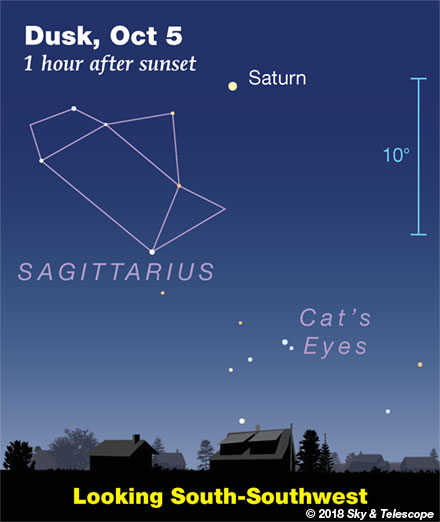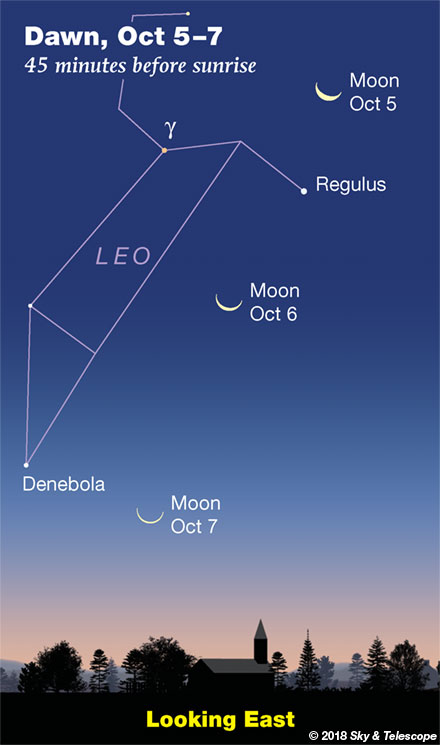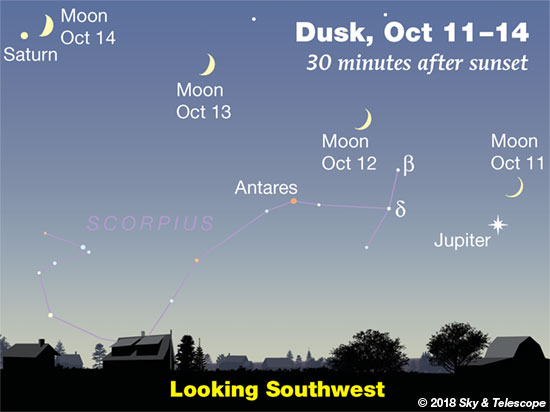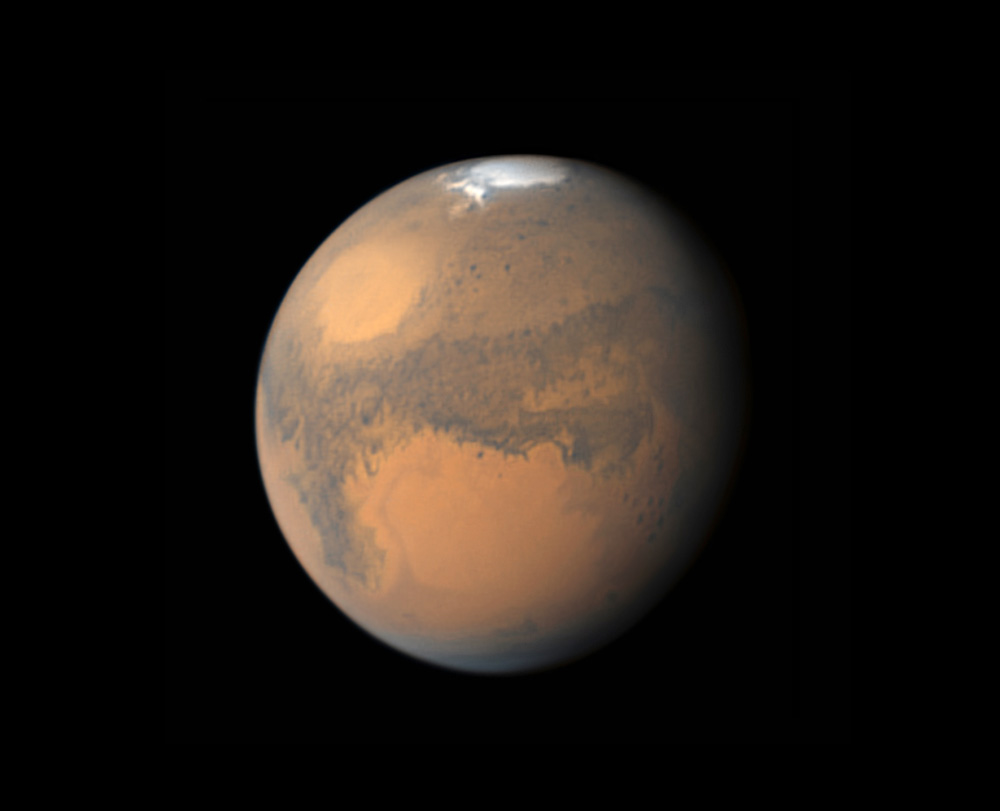

Friday, October 5
• Saturn remains glowing in the south-southwest in twilight, as shown here. You'll need to wait to nearly the end of twilight for the Sagittarius Teapot to come into view.
• On October evenings the Great Square of Pegasus stands high in the east, still tipped onto one corner. It's a little larger than your fist held at arm's length.
Away from its left corner runs the big line of three similarly bright stars marking the main line of Andromeda.
As evening grows later, the Square's upper-right side points far down to Fomalhaut on the rise (four or five fists distant).
Saturday, October 6
• Vega is the brightest star very high in the west after dark. To its right by 14° (nearly a fist and a half at arm's length) look for Eltanin, the nose of Draco the Dragon. The rest of Draco's fainter, lozenge-shaped head is a little farther behind. Draco always eyes Vega!
Sunday, October 7
• The Big Dipper lies down horizontal low in the north-northwest in late evening. How low? The farther south you are, the lower. Seen from 40° north (New York, Denver) even its bottom stars twinkle nearly ten degrees high. But at Miami (26° N) the entire Dipper skims along out of sight just below the northern horizon.
Monday, October 8
• New Moon (exact at 11:47 p.m. EDT).
• The starry W of Cassiopeia stands high in the northeast after dark. The right-hand side of the W (the brightest side) is tilted steeply up.
Look along the second segment of the W counting down from the top. Notice the dim naked-eye stars along that segment (not counting its two ends). The brightest of these, on the right, is Eta Cassiopeiae, magnitude 3.4, a Sun-like star just 19 light-years away with an orange-dwarf companion — a lovely binary in a telescope.
The "one" on the left, fainter, is a naked-eye pair when seen in a dark sky: Upsilon1 and Upsilon2 Cassiopeiae, 0.3° apart. They're orange giants unrelated to each other, 200 and 400 light-years distant from us. Upsilon1, slightly the fainter, is the farther one.
Tuesday, October 9
• The Great Square of Pegasus balances on its corner high in the east at nightfall this week. For your date and location, when it is exactly balanced? That is, when is the Square's top corner exactly above its bottom corner? It'll be sometime soon after the end of twilight, depending on both your latitude and longitude. Try lining up the two stars with the vertical edge of a building.
Wednesday, October 10
• Cygnus floats high overhead these evenings. Its brightest stars form the big Northern Cross. When you face southwest and crane your head to the zenith, the cross appears oriented upright. It's about two fists at arm's length tall, with Deneb forming its top.
The bottom star of the cross is Albireo, not very bright. It's a fine double star for 10x binoculars, but how well you can resolve it in binoculars depends on their optical quality and how steady you can brace them.
From Albireo, you can star-hop to the planetary nebula M27 and to lesser-known Stock 1, a very large but sparse star cluster, using Matt Wedel's Binocular Highlight column and chart in the October Sky & Telescope, page 43.

Thursday, October 11
• As twilight fades, a thin crescent Moon hangs over Jupiter low in the southwest, as shown at right.
Friday, October 12
• Looking lower left of the crescent Moon in twilight, can you spot orange Antares, as shown here? For North Americans it's about 8° from the Moon, a little less than a fist at arm's length.
Off to the right of Antares shines brighter Jupiter.
Saturday, October 13
• The Moon hangs in the southwest after sunset. How early in the fading light can you spot Saturn, about 14° to the Moon's left?
Next, look for fainter, more difficult Antares about the same distance to the Moon's lower right.
________________________
Want to become a better astronomer? Learn your way around the constellations! They're the key to locating everything fainter and deeper to hunt with binoculars or a telescope.
This is an outdoor nature hobby. For an easy-to-use constellation guide covering the whole evening sky, use the big monthly map in the center of each issue of Sky & Telescope, the essential guide to astronomy.

Once you get a telescope, to put it to good use you'll need a detailed, large-scale sky atlas (set of charts). The basic standard is the Pocket Sky Atlas (in either the original or Jumbo Edition), which shows stars to magnitude 7.6.
Next up is the larger and deeper Sky Atlas 2000.0, plotting stars to magnitude 8.5; nearly three times as many. The next up, once you know your way around, are the even larger Interstellarum atlas (stars to magnitude 9.5) and Uranometria 2000.0 (stars to magnitude 9.75). And read how to use sky charts with a telescope.
You'll also want a good deep-sky guidebook, such as Sue French's Deep-Sky Wonders collection (which includes its own charts), Sky Atlas 2000.0 Companion by Strong and Sinnott, or the bigger Night Sky Observer's Guide by Kepple and Sanner.
Can a computerized telescope replace charts? Not for beginners, I don't think, and not on mounts and tripods that are less than top-quality mechanically (meaning heavy and expensive). And as Terence Dickinson and Alan Dyer say in their Backyard Astronomer's Guide, "A full appreciation of the universe cannot come without developing the skills to find things in the sky and understanding how the sky works. This knowledge comes only by spending time under the stars with star maps in hand."
This Week's Planet Roundup
Mercury and Venus are buried very low in the glow of sunset. You may still catch Venus 10 or 15 minutes after sunset; bring binoculars. Sweep for it carefully above the southwest horizon. Don't confuse Venus with Jupiter, higher and easier. Venus is about 15° to Jupiter's lower right.
In a telescope, however, Venus is an increasingly dramatic thin crescent, enlarging as it approaches Earth. It's now only about 10% sunlit, waning daily, and 50 arcseconds tall. But for decent telescopic seeing you'll have to catch Venus high in a blue sky long before sunset.

In a telescope Mars shrinks from 15 to 14 arcseconds wide this week, and it's very obviously gibbous: only 88 percent sunlit, almost as gibbous as we ever see Mars. For a Mars map that displays which side is facing Earth at your time and date, use our Mars Profiler.
Jupiter (magnitude –1.8, in Libra) is getting quite low in the southwest in twilight. It sets around twilight's end.
Saturn (magnitude +0.5, above the spout-tip of the Sagittarius Teapot) glows pale yellow in the south-southwest in late dusk, as shown at the top of this page. Get your telescope on it early before it sinks low. Saturn is three or four fists at arm's length to the right or lower right of Mars.
Uranus, near the Aries-Pisces border, is easy in binoculars at magnitude 5.7 — if you have a finder chart and know the constellations well enough to see where to start with it.
Neptune, in Aquarius, is harder at magnitude 7.8. By mid-evening they are well up in the east and southeast, respectively. Finder charts for Uranus and Neptune, or see the September Sky & Telescope, page 48.
______________________
All descriptions that relate to your horizon — including the words up, down, right, and left — are written for the world's mid-northern latitudes. Descriptions that also depend on longitude (mainly Moon positions) are for North America.
Eastern Daylight Time (EDT) is Universal Time (also called UT, UTC, GMT, or Z time) minus 4 hours.
______________________
"Rational and innocent entertainment of the highest kind."
— John Mills, 19th century Scottish manufacturer and founder of Mills Observatory, on amateur astronomy.
______________________
"The dangers of not thinking clearly are much greater now than ever before. It's not that there's something new in our way of thinking, it's that credulous and confused thinking can be much more lethal in ways it was never before."
— Carl Sagan, 1996
______________________
"Objective reality exists. Facts are often determinable. Vaccines save lives. Carbon dioxide warms the globe. Bacteria evolve to thwart antibiotics, because evolution. Science and reason are not a liberal conspiracy. They are how we determine facts. Civilization's survival depends on our ability, and willingness, to do this."
— Alan MacRobert, your Sky at a Glance editor
______________________
"Facts are stubborn things."
— John Adams, 1770
 1
1








Comments
Jakob
October 6, 2018 at 6:09 am
Our astro friends south of the equator has a two week span seeing earths five companions in the solar system without optimal aid. Wish I was "down under". J
You must be logged in to post a comment.
You must be logged in to post a comment.